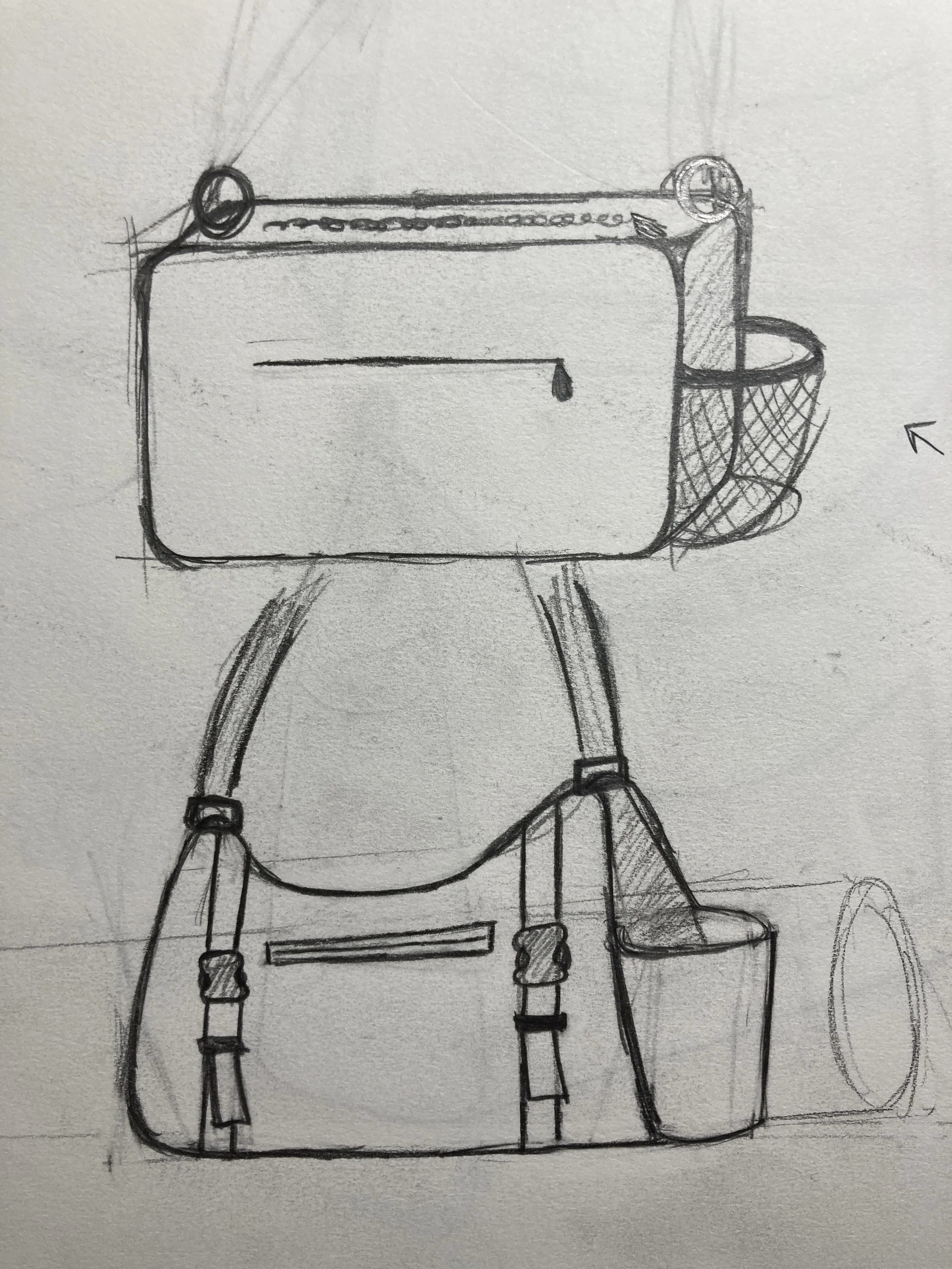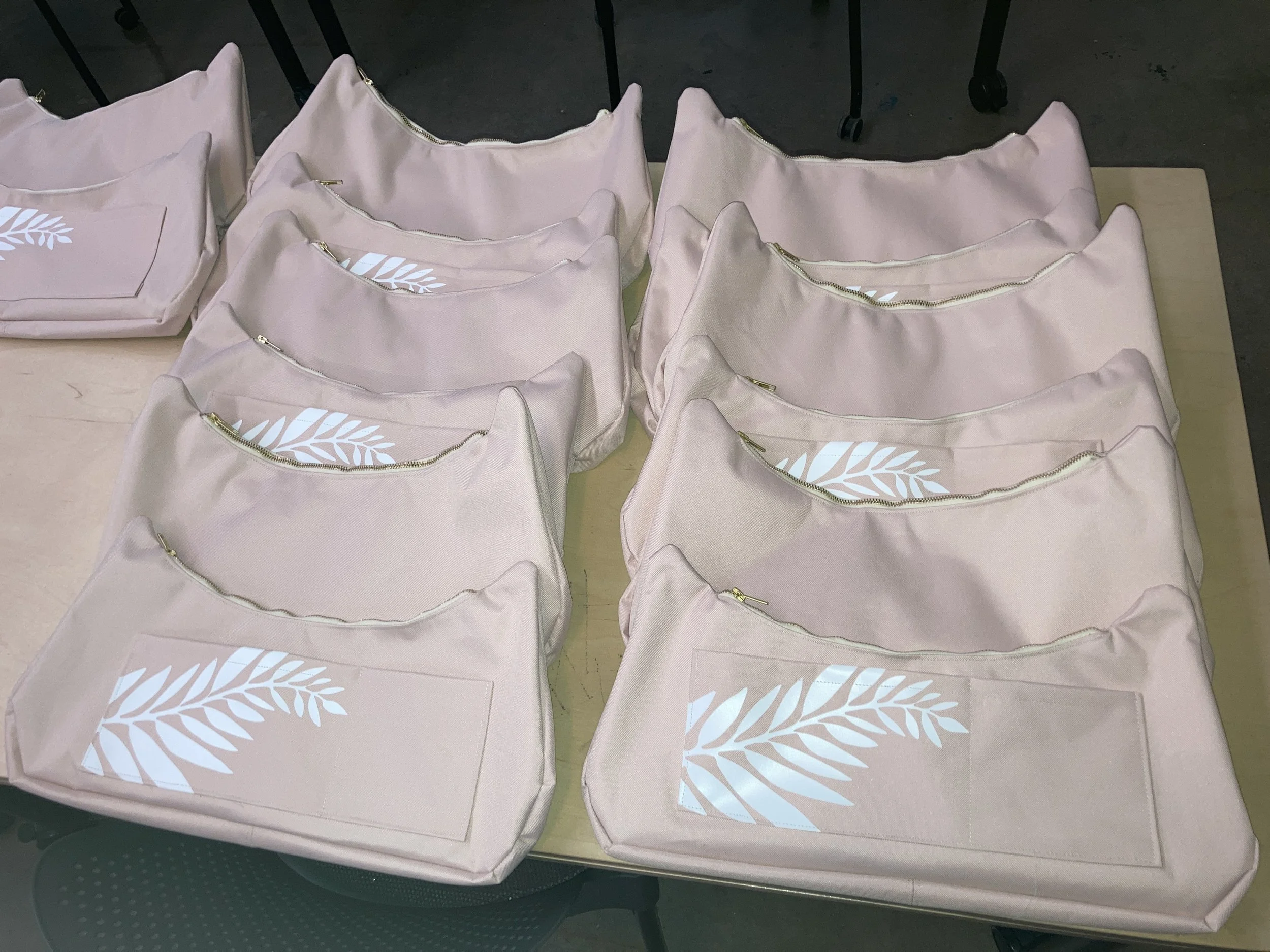FitVantage- Yoga Mat Bag
Fall 2022
FitVantage is a yoga mat accessory bag that not only makes carrying your yoga mat simple and carefree, but provides storage for other gym items while making a statement. By combining the yoga mat carrier and the standard gym bag we were able to design a new functional and stylish way to transport gym equipment.
Design Prompt
Create a product that solves a problem. Manufacture 15 of these products and sell them at a pop-up shop on campus.
Market Analysis
By going into stores and looking at current products we noticed there was a variety of fitness products but not many for their transportation.Transportation is a huge issue for college students since most do not own cars and must either walk, bike, or bus to the gym.
The team decided to create a product that could solve the burden of taking items to the gym.
Survey Analysis
To get direct feedback from our demographic, we did a survey with 18 local students who had a regular fitness routine. The most important items being transported to and from the gym were phones, water bottles, headphones, wallet, keys, and yoga mats. Or those who responded, 41% said they regularly take a yoga mat with them to the gym. This led us to narrow down our product to bags that would accommodate these items.
Due to the yoga mat’s unusual size and shape, finding a bag that can fit a yoga mat presents a challenge. We focused our efforts on designing a bag with a quick and easy way to store and retrieve a user’s mat and other gym equipment.
Demographic Research
The end user of yoga products is majority female, with women doing yoga over twice as much as men. From 2017, the CDC reports that 20% of women in the last 12 months did yoga, compared to men at 9%. With women making up around 70% of the yoga user base, our target demographic is females of college age.
Market Shortcomings
Measuring each product by practicality, aesthetics, and accessibility shows that most products on the market, ranging from low to high in price could all benefit from an upgrade. Almost all bags suffer from a lack of accessibility and aesthetics. Some well-needed improvements include key, phone, and bottle accessibility, as well as adjustable straps for comfort.
Concepting Sketches
Focusing on accessibility, we quickly learned we did not want to have the mat inside of a pouch or zipper in order to access it. Combined with the large size required to encapsulate a yoga mat, we decided to keep the mat on the exterior. Taking inspiration from duffel bags, we attemped to design a product that had plenty of space within, but the result seemed too bulky and complex.
We eliminated the idea of a bag that went on a persons back due to the lack of accessibility to keys, phones, and wallets. When a person is going to the gym or their car, the user needs quick and easy access to these items. Putting a pocket on the side allows for a much smoother experience.
Accessory Research
From our observations of people at the gym, almost every person had a reusable water bottle with Hydroflask and Gatorade being the most popular brands with Hydroflask being most popular among women. Since yoga’s demographic is majority female (CDC), we decided to research accessory products marketed to and popular among women. Since we initially wanted to include a water bottle holder on our bag, we needed to find out what the standard size for a water bottle is.
While single use plastic bottles are standardized, we quickly found out that reusable plastic and metal water bottles are not standardized. With radii measuring from 2.9 to 4.8 inches, it would not be easy to make a one size fits all bottle holder. Especially with water weighing the front of the bag down and potentially ruining the balance both aesthetically and practically, we moved away from including a water bottle holder all together.
Navy Gold
Rose Gold
Color, Material, Finish
We chose the antique brass rings to go with the pink canvas since Rose Gold and Navy are extremely popular color choices for women’s apparel and accessories. Initially we tested gold rings, but they were too bright, so we went with antique brass which is muted but glows gold in sunlight. To compliment the natural cotton and antique brass rings we found a matching YKK metal zipper. YKK is a well known zipper brand for having high quality zippers, so naturally we bought the highest quality zipper we could find since plastic zippers have long-term durability issues
Prototype 1 & User Testing
With the first prototype our team was able to test comfort and ease of use. We tested two kinds of straps with users, polypropylene and cotton. The majority preferred cotton straps since it was softer on the shoulder and had a nicer texture. The material has a tendency to soak up water, so we kept looking for a better material.
After extensive user testing, our team realized that the experience of picking up the bag could be improved if there was a small set of handles in the middle of the bag. We also wanted to ensure that no fraying occured, so on our future model we opted for rolled hems and serged seams.
Finalized Flat Pattern
Prototype 2
With the addition of central handles, the user experience was greatly improved. Picking up and moving the bag short distances is no longer a hassle. Rather than only one piece of fabric be used at the junction where the bag meets the ring, two are used for improved strength and premium feel. However, we felt the bag was missing personality.
On the final model, we decided that the addition of a white leaf decal gave the personal touch we were looking for. Soon after this decision we took to manufacturing eighteen bags for our pop-up shop.
Bill of Materials
Manufacturing
We chose to do an assembly line style manufacturing, where all bags are on the same step of manufacturing at the same time. This makes for maximum efficiency, rather doing each bag one-by-one. Each prototype took around 4-5 hours to make, and with our assembly line we were able to cut that number nearly in half.
All of the sewing was done on a Janome household sewing machine. The first item assembled were the pockets, which had the decal heat transferred onto the surface. Then bottom panels were assembled, with each side of the bag being constructed before sewing the zippers on, followed by their assembly and stitching to the bottom panel.
Final Model Navy
Final Model Rose
Pop-Up Shop
Our product was sold along with others from our class in the Industrial Design Pop-Up Shop hosted by the Siebel Center of Design. Our product was extremely successful, selling out on the first day. We achieved this by allowing pre-orders so that by the first day of the sale, people only needed to pick up their product and pay for it at our table. We offered payment in cash, card, and through Venmo and Paypal.
Final Sales Analysis
Excluding all other items we sold at our shop, we managed to make a profit off of our product. We came close to breaking even, and in order to turn a better profit we would need to sell our bags for more than $40 each. In a real scenario we would have access to bulk and wholesale pricing to cut down costs while turning a better profit. However, this experience allowed us to understand how design and business are tightly linked.
Our final sales demographic shows that our predicted sales demographic was correct. Out of 17 bags solds, only 3 were bought by males. The product sold highest among women with them making up 79% of our sales. This percentage also matches the ratio of women to men who participate in yoga from our earlier statistics. There was a wider age range than initially expected, but young adults and college students made up the majority of our sales, with 29% being middle-aged adults and one purchase being from an elderly woman.
Photo Gallery













































































